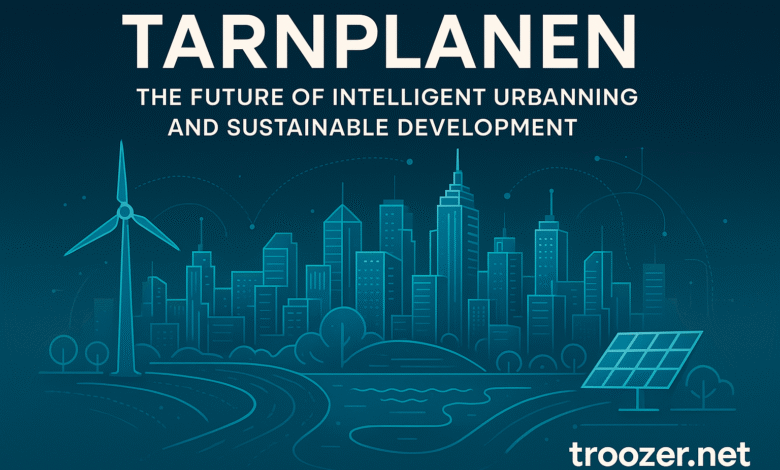Tarnplanen: The Future of Intelligent Urban Planning and Sustainable Development

In an era where cities are expanding rapidly and environmental concerns are reaching critical levels, innovative planning systems are becoming more essential than ever. One such concept gaining attention in recent years is Tarnplanen — a term that represents the fusion of technology, sustainability, and intelligent urban management. While the name might sound futuristic, Tarnplanen is a concept rooted in modern needs: creating cities that are efficient, livable, and resilient in the face of changing global dynamics.
Understanding the Concept of Tarnplanen
Tarnplanen refers to an advanced framework or system designed for strategic urban and regional planning. The term is often associated with intelligent data-driven solutions that help planners, architects, and policymakers develop better infrastructure and land-use strategies. Tarnplanen is not limited to city design; it integrates multiple disciplines such as environmental science, civil engineering, artificial intelligence (AI), and social innovation.
The word “Tarnplanen” itself evokes the idea of “targeted planning” — a structured, adaptive, and holistic approach to building environments that meet both human and ecological needs. By using data analytics, real-time simulations, and community-driven insights, Tarnplanen enables cities to evolve in harmony with nature while fostering economic and social growth.
The Vision Behind Tarnplanen
The primary goal of Tarnplanen is to create smart, sustainable, and connected cities. It moves beyond traditional zoning and development policies, emphasizing digital tools and sustainability metrics to make informed decisions. In many ways, Tarnplanen is the next step in the evolution of smart city initiatives.
Its vision includes:
-
Sustainable Resource Management – Reducing waste, optimizing energy use, and integrating renewable energy systems.
-
Data-Driven Infrastructure Design – Using real-time data from sensors, traffic systems, and climate models to plan infrastructure dynamically.
-
Community Involvement – Encouraging public participation through digital platforms where citizens can contribute ideas or raise concerns.
-
Climate-Resilient Cities – Designing infrastructure that can withstand climate change impacts such as flooding, heatwaves, and rising sea levels.
Tarnplanen and Technological Integration
One of the key strengths of Tarnplanen lies in its technological integration. Advanced digital tools such as Geographic Information Systems (GIS), AI-powered predictive modeling, and Internet of Things (IoT) sensors are used to gather and process large volumes of data. This data helps city planners make evidence-based decisions rather than relying on outdated assumptions.
AI algorithms can predict traffic congestion patterns or pollution hotspots. Similarly, IoT-enabled waste bins can signal when they need to be emptied, optimizing waste collection routes. Tarnplanen integrates these systems to create a seamless flow of information between public agencies, private sectors, and local communities.
Furthermore, digital twins — virtual replicas of real-world environments — play a vital role in Tarnplanen. City planners can use digital twins to simulate how new construction projects, transportation systems, or environmental changes might affect a region before making costly real-world investments.
Environmental Sustainability and Tarnplanen
A defining feature of Tarnplanen is its commitment to environmental sustainability. With global warming intensifying and natural resources depleting, the need for eco-conscious urban design is undeniable. Tarnplanen ensures that sustainability is embedded in every planning decision.
This includes:
-
Promoting green building standards and eco-friendly materials.
-
Encouraging mixed-use developments that reduce transportation emissions.
-
Prioritizing public transportation and cycling lanes over car-dependent infrastructure.
-
Preserving natural landscapes, parks, and wetlands as part of urban ecosystems.
By focusing on sustainability, Tarnplanen aims to balance urban growth with environmental preservation — creating spaces where people can thrive without compromising future generations.
Social and Economic Impact
Beyond its environmental implications, Tarnplanen also emphasizes social equity and economic vitality. Urban planning has historically faced challenges related to inequality — such as housing shortages, poor public services, and lack of access to green spaces. Tarnplanen addresses these by incorporating inclusive design principles.
For example, affordable housing is prioritized alongside high-end developments, ensuring mixed-income communities. Public spaces are designed to be accessible for all ages and abilities. Economically, Tarnplanen encourages innovation hubs, co-working zones, and smart logistics centers that attract businesses and create new employment opportunities.
When properly implemented, Tarnplanen can transform urban centers into dynamic, inclusive, and self-sustaining communities that support both prosperity and well-being.
The Global Relevance of Tarnplanen
Though the term “Tarnplanen” may have European linguistic roots, its philosophy resonates globally. Cities across Asia, the Middle East, and the Americas are adopting similar frameworks under different names — all driven by the same goal: to build better, smarter, and greener urban environments.
In nations facing rapid urbanization, Tarnplanen can serve as a guiding principle to avoid overcrowded, unplanned, and resource-draining development. Meanwhile, in highly developed countries, it can help modernize aging infrastructure and meet carbon neutrality targets.
Challenges and the Path Forward
Like any transformative idea, Tarnplanen faces challenges. These include funding limitations, data privacy concerns, and bureaucratic resistance to technological change. However, with growing global awareness of sustainability and smart governance, these obstacles are gradually being overcome.
The future of Tarnplanen depends on collaboration — between governments, private enterprises, academic institutions, and citizens. When all stakeholders work together, Tarnplanen becomes more than a planning method; it becomes a living ecosystem of innovation and sustainability.
Read More: Mariano Iduba: A Visionary Mind in Modern Innovation and Digital Influence
Conclusion
Tarnplanen represents the evolution of urban planning into a more intelligent, inclusive, and sustainable discipline. It integrates technology, environmental science, and human-centered design to create future-ready cities. As populations grow and climate challenges intensify, the principles behind Tarnplanen will likely become essential to global urban development strategies.
The future belongs to those who plan wisely — and with Tarnplanen, that future looks smarter, greener, and brighter for everyone.



